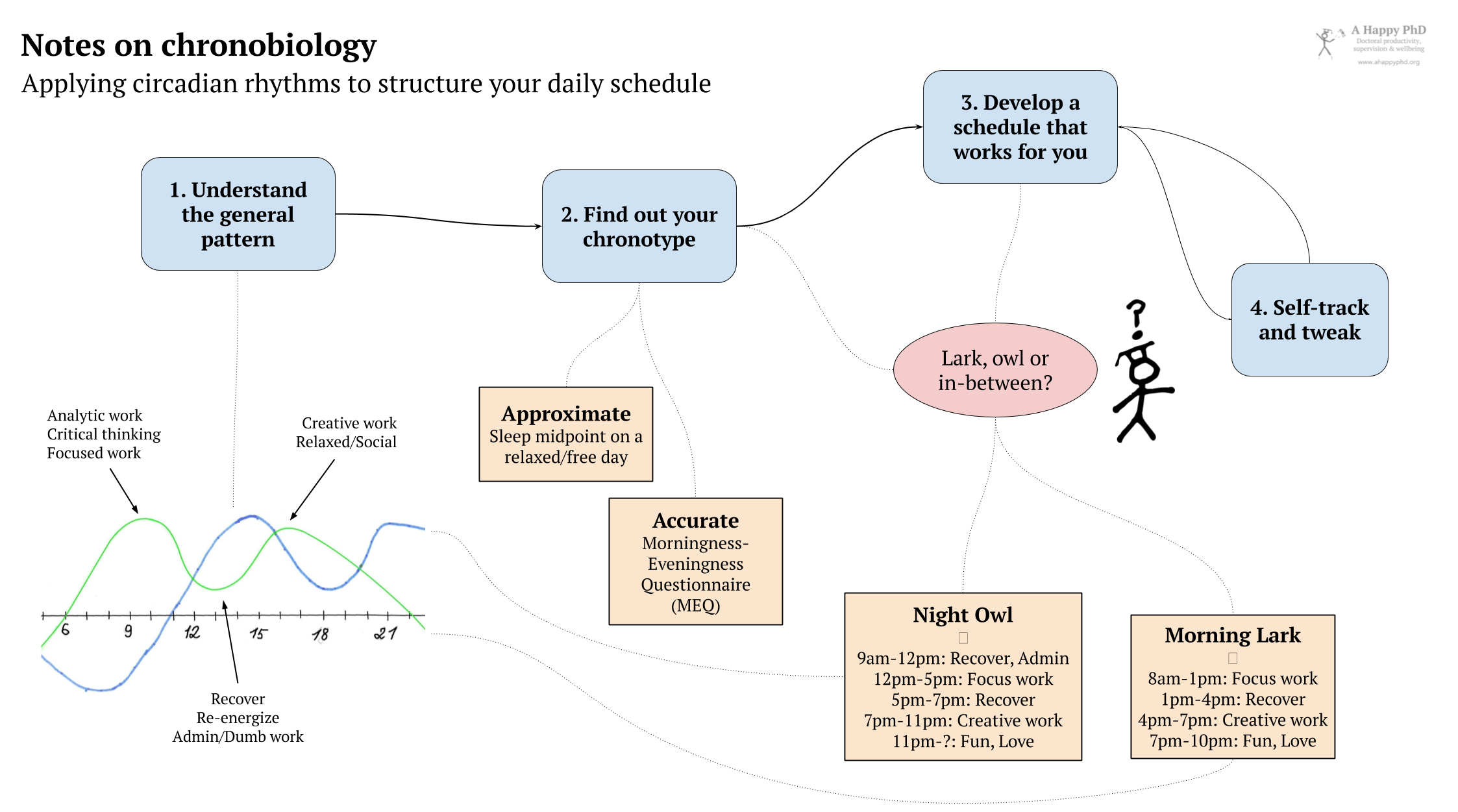POSTS
Notes on chronobiology for the PhD (I): Circadian rhythms
by Luis P. Prieto, - 7 minutes read - 1356 wordsHave you ever felt, after lunch, that your mind cannot focus? or that, later on, writing suddenly feels effortless? If you have noticed trends in when these experiences happen, you have stumbled into the importance of chronobiology for your productivity. In this and following posts, I provide advice on how to organize your research work, based on chronobiology research. Today, circadian rhythms – i.e., when to do what during the day.
By now we know that doing a PhD (or research in general) is hard: writing is hard; giving and receiving feedback is painful; emotional distress and the temptation to abandon the PhD are snares waiting to trip us up at every corner… There are no certainties in doing a PhD (that’s why it’s called “research”, as the old adage goes). Yet, as it happened with the issue of dropping out of the PhD, there are ways of loading the odds to favour our side. Knowing a few basic chronobiology facts, observing ourselves, and rearranging our workday in consequence, can help us be more effective at our craft.
Chronobiology studies timing processes in living organisms, including periodic cycles (e.g., solar, lunar rhythms)1. While there is little research into PhD student-specific chronobiology2, general insights from this field (nicely summarized in books like Dan Pink’s When3) can still be very helpful.
Circ… what? rhythms
The most important chronobiology cycle, and our daily life is… well, the day. You may have heard about “circadian rhythms”, which are the natural, internal processes that regulate our sleep-wake cycle, repeating roughly every 24 hours. The rising and falling of hormones, neurotransmitters, etc. during these processes, in turn, affects our alertness and our ability to think analytically.
For most of us, alertness and ability to focus tend to rise shortly after waking up, reaching their peak in the late morning. Then, in the early afternoon they drop, and later they recover, only to fall in the night again. You can see a rough sketch of this pattern in the image below.
Yet, people actually differ quite a bit in the exact times where these peaks and troughs happen (see the blue line in the figure above). Which leads us to chronotypes…
Find your chronotype
Our chronotype is the particular behavioral manifestation of our circadian rhythm: when do we naturally go to sleep? when do we wake up? when is our usual peak alertness? Chronobiologists often talk about morningness (i.e., naturally getting up very early – the prototypical “morning lark”), or eveningness (i.e., the tendency to get up later and stay up late in the night – the classic “night owl”). Most people fall into the medium-to-morning part of this continuum. Yet, there is an large minority (15% by some measures) of clear “night owls” among us.
How do you know your level of morningness-eveningness? If you want to be rigorous, I recommend taking the Morningness-Eveningness Questionnaire (MEQ)4. There is also a simpler heuristic to find your approximate chronotype:
- Think of a “free day” in which you are not exhausted nor have obligations or appointments (like going to work early, dropping the kids at school, or socializing late in the evening). Like a calm, lazy day in the middle of a long holiday.
- What time would you naturally go to sleep and wake up in such a day? Find the middle point between those two events. If your midpoint is before 3:30am, you’re probably more of a morning lark; if your sleep midpoint is later than 6am, you’re a night owl5. Most people will fall somewhere in between.
Set an ideal schedule (for you)
With these two pieces of information (the general pattern of alertness and your own chronotype), you can start designing your “ideal work schedule” – as much as your life circumstances allow. Fortunately, many PhD students have quite a lot of leeway in how they can structure their work, compared with other professions!
A typical morning-to-medium PhD student could do worse than follow this schedule, adapted from that of writer Joyce Carol Oates3:
- Have a longer span of morning work, approximately 8:30am–1:00pm. In this band, accumulate as much analytical, high-focus work as you can, while your mind is working optimally. Data analysis, paper manuscript editing, research planning, all fit well in this category. Personally, I try to spend at least two hours of uninterrupted focused work in my mornings, before I engage in meetings or email.
- Recover your energy in the early afternoon, e.g., 1:00pm–4:00pm. You can do some vigorous exercise or just go for a walk (bonus points if you go in nature, even if it is just a nearby park). Have lunch with friends or colleagues or, if you have to work, place tasks like email, administrative chores or meetings (as long as there are no high-stakes decisions involved). I have now moved my running workouts to this band, to get as much natural sunlight as I can and avoid “winter depression”.
- Have another bout of work in the late afternoon, e.g., 4:00pm–7:00pm. In this band you can do some more relaxed, creative work (our “inner critic” seems to relax a bit by this time). Brainstorming ideas for new studies, or putting out “shitty first drafts” of a manuscript (“step 0” of my paper writing process) fit this band well.
- Finish up your day with more recovery activities: socializing, hobbies, maybe exercising, or having dinner and enjoying time with your family and loved ones. Disconnect from work completely after an effective workday. Gradually choose calmer activities as the evening passes, to prepare yourself for bed. Avoid screens late in the evening.
What if you are a certified night owl? The schedule above will be hell, as your peak and trough times are shifted by about six hours. Night owls would rather put most of their work in the early afternoon (12:00–5:00pm), maybe do a pause for dinner and recharging (5:00–7:00pm) and then do another stretch of work in the late evening (7:00-11:00pm).
It is worth mentioning again: we are all different. The best schedule is the one we can actually keep without too much stress (regularity is key!). Keeping a journal and noting down our moods and energy throughout the day, can help understand our particular chronotype and fine-tune our schedule. Personally, I have recently found (after a lot of trial and error) that early morning exercise suits me well, as it boosts my mood for the whole day afterwards.
Do you have other ways to structure your day and manage your energy? Did you try hacking your daily schedule? How did it affect your energy levels and productivity? Tell us in the comments section below!
Header image by Pixnio.
-
Dunlap, J. C., Loros, J. J., & DeCoursey, P. J. (2004). Chronobiology: Biological timekeeping. Sinauer Associates. ↩︎
-
There is some evidence, for example, that students with evening chronotypes are more prone to depression… But the study was done on medical students in Mexico, so it is hard to say how generalizable the results are to PhD students in different disciplines. Romo-Nava, F., Tafoya, S. A., Gutiérrez-Soriano, J., Osorio, Y., Carriedo, P., Ocampo, B., Bobadilla, R. I., & Heinze, G. (2016). The association between chronotype and perceived academic stress to depression in medical students. Chronobiology International, 33(10), 1359–1368. In any case, if you are an evening person, it is probably a good idea to watch out for this and other risk factors, and having some mental health tricks up your sleeve, just in case. ↩︎
-
Pink, D. H. (2019). When: The scientific secrets of perfect timing. Penguin Press. ↩︎
-
Horne, J. A., & Östberg, O. (1976). A self-assessment questionnaire to determine morningness-eveningness in human circadian rhythms. International Journal of Chronobiology. ↩︎
-
This 3:30–6:00am cutoff rule of thumb works if you live in a country where the timezone roughly coincides well with the sun’s daily rhythm. For instance, in a country like Spain, which is way West of its “natural timezone”, the solar midday time is often around 1-2pm! In this case, you may have to adjust the cutoff points to 4:30–7:00am. ↩︎

Luis P. Prieto
Luis P. is a Ramón y Cajal research fellow at the University of Valladolid (Spain), investigating learning technologies, especially learning analytics. He is also an avid learner about doctoral education and supervision, and he's the main author at the A Happy PhD blog.

